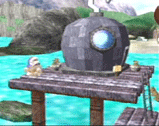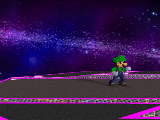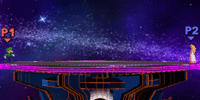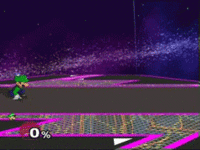Wavedash: Difference between revisions
ScoreCounter (talk | contribs) (Okay, misinterpretation AWAY!) |
ScoreCounter (talk | contribs) m (Reverted edits by ScoreCounter (talk) to last version by Poultry.) |
||
| Line 2: | Line 2: | ||
<!-- Please understand that wavedashing is not a glitch. Do not add any information about how wavedashing is a glitch --> | <!-- Please understand that wavedashing is not a glitch. Do not add any information about how wavedashing is a glitch --> | ||
[[Image:wavedashbig.gif|thumb|frame|The longest wavedash ({{SSBM|Luigi}}) and the shortest ({{SSBM|Peach}}).]] | [[Image:wavedashbig.gif|thumb|frame|The longest wavedash ({{SSBM|Luigi}}) and the shortest ({{SSBM|Peach}}).]] | ||
A '''wavedash''' is | A '''wavedash''' is a technique/physics engine exploit in ''[[Super Smash Bros. Melee]]'' that is performed by [[air dodging]] diagonally into the ground, causing the character to slide a short distance. While it is uncommon in casual play, high-level play of ''Melee'' effectively requires proper use of the technique; the ''Melee'' community sees wavedashing as an advanced technique superior to [[dashing]] because it allows players to perform any ground action while moving horizontally on the ground. Use of the technique is especially important for the metagame of characters with poor traction, such as {{SSBM|Luigi}}, {{SSBM|Mewtwo}}, and the {{SSBM|Ice Climbers}}, and almost every other [[character]] requires some use of wavedashing for positioning and maneuvering, particularly in combos and [[mindgame]]s. | ||
Contrary to popular belief, wavedashing is not strictly a glitch; it is more accurately a {{S|wikipedia|corner case}} of ''Melee''{{'}}s physics engine. In an interview, [[Masahiro Sakurai]] acknowledged that the dev team was aware of wavedashing during development. When air dodging diagonally to the ground, all of the momentum of the airdodge is transferred into horizontal (ground) movement, since the character can no longer fall. Additionally, performing a wavedash causes the game to recognize the character as landing from the [[helpless]] state due to air dodges causing the state. Thus, the game is not recognizing wavedashing as a specific "technique" (such as an attack or movement) but as if the character simply landed and stood still; the sliding effect is due to the "slipperiness" inherent in the game's engine. | Contrary to popular belief, wavedashing is not strictly a glitch; it is more accurately a {{S|wikipedia|corner case}} of ''Melee''{{'}}s physics engine. In an interview, [[Masahiro Sakurai]] acknowledged that the dev team was aware of wavedashing during development. When air dodging diagonally to the ground, all of the momentum of the airdodge is transferred into horizontal (ground) movement, since the character can no longer fall. Additionally, performing a wavedash causes the game to recognize the character as landing from the [[helpless]] state due to air dodges causing the state. Thus, the game is not recognizing wavedashing as a specific "technique" (such as an attack or movement) but as if the character simply landed and stood still; the sliding effect is due to the "slipperiness" inherent in the game's engine. | ||
Revision as of 16:21, April 1, 2016
A wavedash is a technique/physics engine exploit in Super Smash Bros. Melee that is performed by air dodging diagonally into the ground, causing the character to slide a short distance. While it is uncommon in casual play, high-level play of Melee effectively requires proper use of the technique; the Melee community sees wavedashing as an advanced technique superior to dashing because it allows players to perform any ground action while moving horizontally on the ground. Use of the technique is especially important for the metagame of characters with poor traction, such as Luigi, Mewtwo, and the Ice Climbers, and almost every other character requires some use of wavedashing for positioning and maneuvering, particularly in combos and mindgames.
Contrary to popular belief, wavedashing is not strictly a glitch; it is more accurately a corner case of Melee's physics engine. In an interview, Masahiro Sakurai acknowledged that the dev team was aware of wavedashing during development. When air dodging diagonally to the ground, all of the momentum of the airdodge is transferred into horizontal (ground) movement, since the character can no longer fall. Additionally, performing a wavedash causes the game to recognize the character as landing from the helpless state due to air dodges causing the state. Thus, the game is not recognizing wavedashing as a specific "technique" (such as an attack or movement) but as if the character simply landed and stood still; the sliding effect is due to the "slipperiness" inherent in the game's engine.
History
Origins and discovery
Wavedashing was first noticed during the development of Melee by Masahiro Sakurai; according to an interview with the magazine Nintendo Power, he elected to not remove the tactic from the game, as he failed to anticipate that it would affect play to a significant degree.
Amongst the community, wavedashing in Melee was discovered within its first year of existence. For many years, it was widely believed that Smashboards veteran and mod Toadbanjoconker discovered the technique in spring 2002. He reportedly discovered the exploit while attempting an aerial item catch during an air dodge; at this point in Melee's history (April 2002), items were considered tournament legal, and this was the preferred method of countering thrown items. Recent developments, however, have demonstrated that wavedashing was actually first discovered by a user named Ultimate Melee in January 2002, with the actual topic being posted on 24 January, around two to three months prior to Toadbanjoconker's discovery. Initially described as "mad dashing", the thread shows some signs of being unused to the new strategy, such as by claiming that the Ice Climbers can most easily perform the tactic; Ultimate Melee, however, did note that it led to some interesting combat applications, such as the ability to perform smash attacks during the move.
The term "wavedash" stemmed from the Tekken fighting game series; in the installment of Tekken Tag Tournament, some characters could perform a rapid, crouching slide, allowing for such characters to quickly pursue attackers and safely parry low attacks, amongst other powerful benefits. A similar tactic with an identical name also existed in the Marvel vs. Capcom series via a rapid series of crouch-cancelled dashes, though it had fewer practical offensive applications than Tekken Tag Tournament.
Effects on competitive Melee
The tactic was initially given little interest by smashers, with many seeing the technique as having little practical application in Melee. The rise of Ken and his Marth, however, caused the realization of the tactic's extreme flexibility; in addition to other techniques, Ken demonstrated that the wavedash allowed for a considerably faster, safer, and more powerful approach when compounded with smash attacks. The technique became a commonplace tactic for players to learn and use in tournaments, and its use ended up significantly altering Melee's early metagame; notably, Marth was no longer derided as a "noob character", and wavedashing had applications to some characters, such as Fox's waveshine. Within a year, wavedashing had become the go-to technique for professional players, though there were a few professional smashers, such as Aniki, refusing to use the technique.
Although now considered an essential technique for Melee gameplay, wavedashing was initially a controversial discovery. Despite increasing the number of options in Melee, numerous debates occurred over wavedashing's legitimacy as a tactic. The majority of the debate focused on whether wavedashing was an intentional feature of the game or a glitch. The debates had the inadvertent effect of spreading numerous misconceptions and myths about the technique. For instance, it was claimed that the game recognized players in the state of "LANDFALLSPECIAL" while sliding during the wavedash; in reality, "landfallspecial" was a generic term used to describe players landing from the helpless state. After Sakurai's confirmation of noticing wavedashing during the development of Melee, the debates slowly died down, with the majority agreeing that wavedashing was an exploit of Melee's physics, not a glitch or intentional technique.
In later games
While Sakurai noted that wavedashing was widespread in an interview, he disliked the idea of it, as he felt it separated beginning and advanced players too strongly; in addition, he wanted players to find new ways to enjoy Brawl. As a result of this, in combination with the desire for more aerial combat, air dodging was reworked for Brawl, with the changes resulting in the absence of wavedashing from Brawl.
This, however, immediately proved controversial in competitive Smash, with smashers becoming divided over whether such a change would or would not impede Brawl's ability to be played at the competitive level. Although Brawl did develop a tournament scene, the absence of wavedashing overall became a major point of contention in the community. Regardless of the controversy, the later Super Smash Bros. 4 retained the air dodge system from Brawl; as such, wavedashing continues to be absent from the game, although some characters' custom moves provide a similar momentum boost.
Technical details
Wavedashing describes a sliding motion that occurs by jumping and then immediately air dodging at a sharp angle into the ground. The length a character slides in their wavedash is determined by a number of factors: by the angle at which they air dodged (low angles yield long wavedashes), how close to ground they were before air dodging (the closer the character, the longer the wavedash), and the character's traction. Low traction yields long wavedashes, while high traction yields short wavedashes. Thus characters like Luigi, Ice Climbers, and Marth have long wavedashes, while Peach and Zelda have short wavedashes. Both long and short wavedashes have their own advantages and disadvantages; while long wavedashes are generally better for approaching and wavesmashing, shorter wavedashes are better for comboing and positioning.
As the length of a wavedash is dependent on the character's traction, surfaces which reduce traction can significantly increase the lengths of wavedashes for all characters, such as the UFO on Fourside and the oil slick on Flat Zone. However, none of the tournament legal stages for Melee feature such surfaces.
Lengths
Wavedash lengths, in order from longest to shortest, are as follows:
| Rank | Character |
|---|---|
| 1 | Luigi |
| 2 | Ice Climbers |
| 3 | Mewtwo |
| 4 | Marth |
| 5 | Yoshi |
| 6 | Roy |
| 7 | Dr. Mario / Mario / Mr. Game & Watch |
| 10 | Samus |
| 11 | Ness |
| 12 | Fox |
| 13 | Bowser |
| 14 | Falco |
| 15 | Young Link |
| 16 | Ganondorf |
| 17 | Donkey Kong |
| 18 | Pikachu / Sheik |
| 20 | Captain Falcon / Kirby |
| 22 | Pichu |
| 23 | Jigglypuff |
| 24 | Link |
| 25 | Peach / Zelda |
Performing the technique
Traditionally, wavedashing is the technique-to-know for newer players, for a mastery of wavedashing reflects both a nimbleness of fingers and a knowledge of high-level play. It is performed by pressing X or Y (or up on the control stick) to jump, followed immediately by L or R, and diagonally down on the control stick, to perform the air dodge. Ideally, the wavedashing character should slide without ever appearing to leave the ground.
Because wavedashing can be difficult to master, some players train themselves by wavedashing directly from a crouching position, which provides them the opportunity to wavedash only by pressing the two buttons (jump and air dodge) instead of timing a control stick movement as well. This method of wavedashing, however, is slow and not optimal for battle.
The speed of a character's jump also impacts the timing of their wavedash - the time interval between the jump and the air dodge is greater for characters with slow jumps (like Bowser and Link) and smaller for characters with fast jumps (like Fox and Pikachu). That said, during a match, one must compensate for startup lag in a wavedash, depending on the character being used.
Advantages of wavedashing
While in a wavedash, the character is considered by the game to be standing - thus, they can perform any ground attacks that could normally be performed from a standing position, such as smashes, standing grabs and jabs. The character also retains all of their standing defensive maneuvers such as sidestepping and shielding. With this extra utility, wavedashing enables a moving versatility dashing can't match.
Another advantage lies in the ability to wavedash backwards while facing forwards, which allows characters to perform standing attacks while moving both backwards and forwards. This is helpful for mindgames, especially with characters with longer wavedashes. This technique also allows relatively safer retreats from opponents, and should the player fall off the stage with the wavedash, they will immediately grab onto the ledge, giving rise to a powerful and fast edgeguard option.
Disadvantages of wavedashing
Despite its versatility, wavedashing requires considerable startup. A character is vulnerable (and not yet moving) while performing the jump and air dodge, and for 10 frames afterwards they are unable to attack (while "landing" from the wavedash). Because of this lag, it is unwieldy for a character to wavedash in close quarters where quick attacks endanger them, and prediction and proper spacing is a must.
As wavedashing requires the use of air dodging, it is possible for players to make errors while air dodging. Regardless of the circumstances, accidental air dodges are frequently detrimental to the player. The player's character, in a state of helplessness, is vulnerable to combos and other attacks immediately after the air dodge. A particularly notable consequence of accidental air dodges is when they occur near the ledge. Referred to as an Azendash after the professional American smasher Azen, the player can end up air dodging off the stage, beyond the range of the edge sweet spot. Although survival is possible if one uses Samus, Young Link or Link, via proper use of their wall grappling techniques, a majority of these errors will lead to a self-destruct.
Strategies
Approach
For some characters, wavedashing is a better form of movement than dashing. This is especially true for characters of low traction and a slow dash, such as Luigi, Ice Climbers and Mewtwo. These characters are special in that almost all their movement is best done via wavedashing. They can wavedash long distances faster than they can dash.
One can take the concept of maneuverability from wavedashing a step further, using to dodge enemy attacks and set up a counterattack. A common example of this tactic: a player faces a charging enemy, who will most likely launch a dash attack or short hop aerial from their dash. To avoid being hit, one can wavedash backwards, dodging the attack and landing an attack of their own during the enemy's lag time. Wavedashing in this fashion is very common in approach-based mindgames.
Wavedashing is a quick way to move but is also instrumental in characters' combos and their defense. Characters with poor rolls or sidesteps, such as Samus and Mr. Game & Watch, rely on wavedashing to extricate themselves from difficult situations.
Additionally, the concept of air dodging into the ground provides a useful segue from a character's air game to their ground game. This is especially important for Luigi, whose slow, floaty air game and speedy ground game lack synergy. A good Luigi player will often follow a short hop aerial with a "waveland" to reposition, giving Luigi a chance to surprise his opponent with a sudden attack or retreat. This technique can only be done by a few characters with a few attacks (other notable examples are Marth's short hop forward aerial and Dr. Mario's short hop back aerial), but for them wavelanding is vital to continuing combos and pressuring the enemy.
Wavesmashing

Wavesmashing is the act of smashing while wavedashing, and is an example of the offensive advantages of wavedashing. Since characters can attack during the slide, a typical offensive movement would be to wavedash forward while smashing, minimizing the startup time of the smash (which would be considerable if a character tried to smash after dashing) and potentially finishing the opponent. Wavesmashing is particularly useful for a character like Luigi whose dash attack is very poor but whose smashes (in Luigi's case, down smash, a vertical launcher) are effective.
Although such terms as "wavetilting", "wavegrabbing", and " wavejabbing" are not as widely used, they fall under the same blanket concept of wavesmashing: that a character can use many and varied attacks while wavedashing.
Wavelanding

Wavelanding is performed after a character jumps to his/her peak and descends. As the character is approaching the ground the player presses L or R, initiating an air dodge. The ground then stops the air dodge animation and begins a normal wavedash. This is especially useful for moving around platforms quickly and for getting onto the stage quickly.
Wavelanding returns in Super Smash Bros. Brawl, with limited uses. It is performed by holding the control stick in a desired direction while air dodging very close to the ground. Unlike wavelanding in Melee, the length of the slide is not dependent on traction, but on the character's air speed.
Wavedropping
A Wavedrop is a useful technique when trying to maintain control while a character is dashing, landing from a jump or a completed aerial attack, or even wavedashing. It can even be used as a mindgame against opponents to some extent. In order to Wavedrop, land from a jump, transition from the last few frames of a dash into a wavedash, or attempt a second wavedash during the initial sequence of the wavedash, but instead of angling the Control Stick as usual, hold it down completely. The character will land in a Wavedashing animation, but remain still. Wavedropping is essentially the same as Wavedashing except that the character doesn't move in any direction.
Waveshielding
Beginning wavedashers often shield right after wavedashing because they do not quickly remove their finger from the L or R button; this idea can be used to a player's advantage as a defensive technique known as waveshielding, the act of shielding right after wavedashing. It's a safe way to travel because the shield blocks most enemy threats. A player can jump-cancel from their shield into another wavedash, allowing them to move with their shield long distances. In a more offensive sense, waveshielding is also an excellent way to set a SHFFL'ing adversary up to be shield-grabbed.
In a similar vein, characters can sidestep and roll during their wavedash, both defensive movements that allow characters to avoid enemy projectiles and attacks (including grabs) without forfeiting movement.
Edge-hogging
Another aspect of wavedashing is that one can fall off platforms backwards, which is impossible by any other technique besides moonwalking, shorthopping backwards, and shielding an attack, with wavedashing being quicker than those three techniques. This seeming oddity has a practical use; it allows characters to edge-hog very quickly. A backwards wavedash towards the edge will topple the combatant over the side of the stage where they will immediately grab the ledge, thereby preventing their opponent from doing the same. Generally, this is the fastest and safest way to edge-hog.
Triangle jumping
Triangle jumping (or "Triangle dash", not to be confused with another term for walljumping) is a technique similar to wavelanding. It only differs in the fact that part of the character's airdodge is allowed to be seen, giving some invincibility frames, yet still moving forward with a slight waveland. It comes from a term used in games like the Marvel vs. Capcom series to describe a mixup tactic used by characters who can air-dash in eight directions.
Other uses
As touched on previously, wavedashing from a jump-canceled shield increases a player's defensive options, allowing them a quick retreat or attack from their shield. On a similar note, wavedashing from a shine allows Fox and Falco to perpetuate their shine combos.
One can wavedash directly onto the stage from hanging on the edge by dropping off, immediately double jumping, and then air dodging back on-stage. This technique is commonly known as ledge dashing. One can waveland onto platforms, a technique often used on three-platform stages such as Battlefield and Yoshi's Story.

